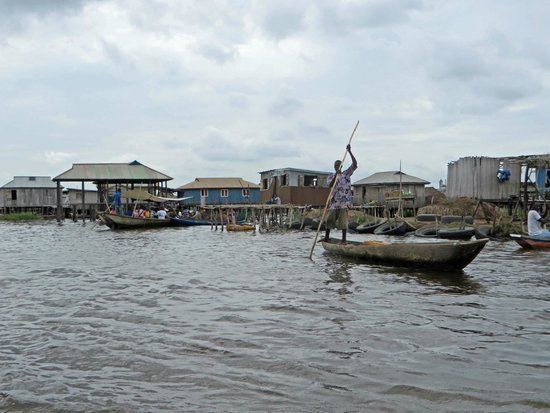Max. width 11 km (6.8 mi) Width 11 km | Max. length 20 km (12 mi) Length 20 km | |
 | ||
Lake Nokoué is a lake in the southern part of Benin. It is 20 km wide and 11 km long and is located at 6.433333°N 2.45°E / 6.433333; 2.45. The water covers an area of 12,000 acres. The lake is partly fed by the Ouémé River and Sô River both of which deposit sediments from throughout the region in the lake.
Contents
Map of Lake Nokoue, Benin
The town of Cotonou sits on the southern border of the lake. Sections of the population of Cotonou have been displaced by coastal and lake flooding. On the northern edge is the town of Ganvié.
Economy
Because of its diverse wildlife, the lake provides an important source of food and economic activity for these towns. Fishing is best when water is low between November and June. Fishing is typically of 30 species of fish, with fish from the Cichlid, Clupeidae and Penaeidae families making 85% of the catch. The fishery became more stressed during the 90s, as more people began fishing on the lake. Fishing is typically artisanal, with small crew dugout canoes catching small batches of fish. The estimated fish production of the lake is 2 tonnes per Hectare per year.
The lake is also used for Acadja, a type of fish breeding facility.
Hydrology
The lake, in large part is a lagoon. With its geometry, the lake is expected to double in size, and flood as global climate change, effects sea level. There is also a risk of salnization, which will change the ecology of the freshwater lake, perhaps making it more brackish. Different sections of the lake currently alternate between fresh and brackish ecosystems at an average depth of 1.5 meters. Normal temperatures throughout the lake are between 27° and 29 °C.
The lake is a site of depositation of both pesticides and heavy metals from upstream industry and human habitation. Though the pesticides are only present in fish at less than toxic levels, the heavy metals in the waters can reach levels in fish both unhealthy for humans and the fish.
Geology
The floor of the lake has a mixture of sandy, sandy-muddy and muddy bottoms.
Ecology
Lake Noko has at least 78 species of fish. A number of bird species exploit the wide variety of fish as food, as well as species of otter.
